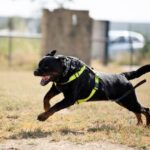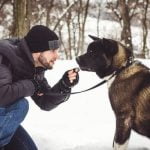If you’ve ever wondered how to train a dog like a police dog, then you understand the importance of proper training for these highly skilled animals. In law enforcement, well-trained police dogs play a critical role in various tasks and responsibilities.
From tracking down suspects to detecting narcotics or explosives, these dogs are invaluable assets in keeping communities safe. This article will explore the significance of training police dogs, the desired traits and characteristics for this specialized work, and provide a comprehensive guide on how to train your own dog to be like a police dog.
Law enforcement agencies rely heavily on properly trained police dogs for their unique capabilities and instincts. These dogs can detect hidden contraband with incredible accuracy, locate missing individuals through scent tracking, apprehend suspects while protecting their handlers, and perform various other tasks that contribute to the successful execution of law enforcement operations. Without adequate training, these dogs would not be able to carry out these duties effectively or reliably.
To become an effective police dog, certain traits and characteristics are crucial. Intelligence is essential as these dogs must learn complex commands and respond appropriately even in high-pressure situations. Obedience is another key trait since it ensures that the dog complies with commands from its handler without hesitation. A strong work ethic is also desirable as it enables the dog to persistently search, track, or apprehend suspects for extended periods of time.
Certain breeds are often favored in police work due to their natural abilities and temperament. German Shepherds and Belgian Malinois are commonly chosen as they possess ideal qualities for police work such as intelligence, agility, strength, loyalty, and courage. However, any breed can potentially excel with the right training and temperament.
In the following sections of this article, we will delve deeper into different aspects of training your dog like a police dog. We will cover basic obedience training which establishes a solid foundation for more advanced techniques such as scent detection and tracking. Communication skills between handler and dog, building trust and respect, and maintaining physical fitness will also be examined.
Furthermore, we will explore practical training scenarios that simulate real-life situations as well as the importance of ongoing training and continued education for a successful career in law enforcement. Stay tuned to learn how you can transform your canine companion into a well-trained police dog.
Traits and Characteristics Required for Police Dogs
Police dogs play a crucial role in law enforcement, and their effectiveness relies heavily on their specific traits and characteristics. To become successful police dogs, certain qualities are desired, including intelligence, obedience, and a strong work ethic. These traits can vary depending on the specific tasks and responsibilities assigned to the dog. Additionally, certain breeds are often favored for police work due to their inherent abilities.
Intelligence is a key trait sought after in police dogs. They need to be able to understand and execute complex commands quickly and accurately. Obedience is equally important as it allows handlers to have control over the dog’s actions and ensures the safety of both the dog and those around them. A strong work ethic is another essential characteristic as police dogs often have demanding tasks that require dedication and perseverance.
Certain breeds are commonly chosen for police work due to their natural abilities. German Shepherds, Belgian Malinois, Labrador Retrievers, and Dutch Shepherds are among the most popular breeds for police dog training. These breeds tend to possess the desired traits necessary for police work such as high trainability, loyalty, physical strength, and agility. However, it’s important to note that individual temperament plays a significant role in determining if a particular dog is suitable for police training.
Establishing a Solid Foundation
Basic obedience training is the foundation for any successful police dog training program. Teaching a dog essential commands not only ensures their safety and the safety of others, but it also sets the groundwork for more advanced training techniques. Here are some steps to establish a solid foundation in basic obedience training:
- Start with the essentials: Begin by teaching your dog simple commands such as sit, stay, and recall (come). These commands are crucial for control and discipline during police work. Use positive reinforcement techniques like treats or praise to reward your dog when they successfully follow a command.
- Be consistent: Consistency is key when it comes to training dogs. Use the same verbal cues and hand signals every time you give a command, so your dog can establish a clear association between the cue and the desired behavior. Practice these commands regularly in different environments to ensure that your dog can perform them reliably in any situation.
- Introduce distractions gradually: As your dog becomes proficient in basic commands, gradually introduce distractions during training sessions to simulate real-life scenarios. Start with mild distractions such as toys or food on the ground, then progress to more challenging distractions like people walking by or loud noises. This will help your dog learn to focus and obey commands even in high-stress situations.
Remember, patience and positive reinforcement are key when training a police dog. Keep training sessions short and frequent, allowing for plenty of breaks and playtime in between. By establishing a solid foundation in basic obedience, you will be preparing your dog for more complex tasks and increasing their overall effectiveness as a police dog.
Additional Resources
Here are some additional resources that may be helpful in establishing a solid foundation through basic obedience training:
- Professional Dog Trainers: Consider enrolling your dog in formal obedience classes taught by professional trainers experienced in working with police dogs. They can provide expert guidance and help you overcome any training challenges.
- Online Tutorials and Videos: Explore online tutorials and videos that offer step-by-step instructions on teaching basic obedience commands. Websites and platforms such as YouTube often have valuable resources shared by professional dog trainers.
- Books and Training Manuals: Look for books and training manuals specifically geared towards police dog training or basic obedience training. These resources often provide detailed explanations, training plans, and troubleshooting advice.
By utilizing these resources and putting in the time and effort to establish a solid foundation in basic obedience training, you will be well on your way to training your dog like a police dog.
Developing Effective Canine Communication Skills
Effective communication is crucial in training a dog to be like a police dog. Dogs cannot understand verbal commands alone; they rely heavily on non-verbal cues and body language. Developing clear communication channels with your dog is essential for successful police dog training. In this section, we will discuss the significance of establishing effective canine communication skills and how to achieve it.
The Importance of Body Language
Body language plays a pivotal role in communicating with dogs. It is necessary to understand how dogs interpret our body language and use that knowledge to convey our intentions effectively. Dogs are observant creatures and can easily pick up on subtle cues such as posture, facial expressions, and hand movements.
For example, when teaching a new command, maintain an upright posture to appear confident and authoritative. Use clear hand signals alongside verbal commands so that the dog has a visual cue to associate with the command. Consistency in body language helps the dog understand what is expected of them.
Establishing Non-Verbal Cues
In addition to body language, establishing consistent non-verbal cues is crucial for successful communication with police dogs. These cues can range from simple gestures like raising an eyebrow for attention or pointing to direct the dog’s focus.
It is important to note that timing is critical when using non-verbal cues. Reward or praise should be given immediately after the desired behavior occurs to reinforce the connection between the cue and the action. Consistency and clarity in non-verbal cues increase the likelihood of appropriately responding behaviors from police dogs during training sessions and real-life scenarios.
Building Trust Through Communication
Establishing trust between handler and police dog enhances communication effectiveness. When trust exists, dogs are more likely to listen attentively and follow instructions even in challenging situations. Building trust requires maintaining consistency throughout training sessions, avoiding punishment-based methods, and utilizing positive reinforcement techniques.
Positive reinforcement involves rewarding desired behaviors with treats, praise, or play. This method helps strengthen the bond between handler and dog while fostering a positive learning environment. By remaining patient, consistent, and understanding during training, handlers can cultivate trust and open communication channels with their police dogs.
Building a Bond of Trust and Respect
Building a strong bond of trust and respect between a police dog and its handler is crucial for successful police work. This bond forms the foundation for an effective partnership and ensures that the dog follows commands, stays focused on tasks, and remains loyal to its handler in high-pressure situations. Here are some tips and techniques to strengthen the bond between a police dog and its handler through regular training sessions.
Firstly, consistent training sessions are essential for building trust and respect. Dogs thrive on routine and structure, so it’s important to establish a regular schedule for training exercises. Consistency in training helps dogs understand expectations and builds confidence in their abilities. Training should incorporate positive reinforcement techniques such as treats, praise, or playtime as rewards for desired behaviors. This positive association deepens the bond between the dog and its handler.
Secondly, communication plays a vital role in building trust and respect. Dogs primarily rely on non-verbal cues such as body language, eye contact, and hand signals to understand their handlers’ commands. It is crucial for handlers to be clear, calm, and assertive in their communication with their dogs.
They should avoid yelling or using harsh physical punishments that could damage the relationship with the dog. By maintaining good communication channels with their dogs during training sessions, handlers can foster mutual understanding and trust.
Thirdly, spending quality time together outside of training sessions can greatly enhance the bond between a police dog and its handler. Activities such as playing fetch, going for long walks, or engaging in interactive games like hide-and-seek provide opportunities for bonding on a deeper level. These activities not only promote physical exercise but also reinforce the handler’s role as a source of fun and care in the dog’s life.
Advanced Training Techniques
Scent detection and tracking are crucial skills for police dogs, as they play a vital role in law enforcement operations. These advanced training techniques enable dogs to locate specific scents and follow trails, making them indispensable assets in search and rescue missions, narcotics detection, and apprehending criminals.
To start training a dog in scent detection and tracking, it is essential to establish a strong foundation in basic obedience commands. This includes commands such as sit, stay, and recall, which help create discipline and focus in the dog. Once these foundational commands are established, specific scent detection and tracking commands can be introduced.
One fundamental aspect of scent detection training is teaching the dog to recognize and identify target odors. This involves exposing the dog to various scents associated with the desired targets (e.g., drugs or explosives) while providing positive reinforcement for correct responses. Over time, the dog learns to associate particular scents with rewards and actively seeks out those scents during training exercises.
Tracking training focuses on teaching the dog to follow human scent trails left by individuals being tracked. Dogs have an innate ability to detect traces of skin cells that humans shed while walking or running. By encouraging the dog to use its natural instincts and honing their skills through consistent practice, handlers can develop highly proficient tracking abilities in their dogs.
It is worth noting that scent detection and tracking require specialized equipment such as scent tubes or scent articles for training purposes. These tools help trainers create controlled scenarios where dogs learn to differentiate between target odors amidst distractions.
Overall, advanced training techniques for scent detection and tracking involve building upon basic obedience skills and introducing specialized commands tailored for this purpose. With patience and consistency, handlers can develop highly efficient police dogs capable of detecting specific scents accurately while swiftly following trails laid by individuals needed for law enforcement operations.
| Advanced Training Techniques: Scent Detection | Advanced Training Techniques: Tracking |
|---|---|
| Involves teaching dogs to recognize and identify target odors | Focuses on teaching dogs to follow human scent trails |
| Requires exposure to various scents associated with desired targets | Utilizes dogs’ innate ability to detect traces of skin cells shed by humans |
| Uses positive reinforcement for correct responses during training exercises | Involves encouraging dogs to use their natural instincts while practicing consistently |
| Specialized equipment such as scent tubes or scent articles may be used for training purposes | Specialized equipment may be used to lay trails and create controlled scenarios for practice |
Agility and Physical Fitness Training for Police Dogs
Agility and physical fitness play a crucial role in the training of police dogs. These dogs are often required to perform demanding tasks such as chasing down suspects, searching large areas, and navigating various terrains. To prepare them for these challenges, it is essential to incorporate agility and physical fitness training into their regimen.
The Significance of Agility and Fitness
Police dogs need to be agile and physically fit to carry out their duties effectively. Agility training focuses on improving a dog’s coordination, balance, and speed, allowing them to navigate obstacles efficiently. This skill is particularly important in situations where quick movements are required, such as chasing down a fleeing suspect or navigating tight spaces during searches.
Furthermore, maintaining high levels of physical fitness is crucial for police dogs. These dogs often need to cover long distances quickly while searching for suspects or tracking scents. They may need to jump over obstacles or crawl through tight spaces without getting stuck. Without proper physical conditioning, they may struggle with endurance and become fatigued more easily.
Exercises and Activities for Agility and Physical Fitness Training
There are several exercises and activities that can help improve the agility and physical fitness of police dogs. One of the most common exercises is agility courses, which consist of various obstacles such as hurdles, tunnels, weave poles, and A-frames. These courses allow dogs to practice their jumping skills, balance, and speed while navigating through different obstacles.
In addition to agility courses, regular aerobic exercise like running or swimming can also enhance a police dog’s physical fitness. Long-distance runs help build endurance while swimming provides a low-impact activity that strengthens muscles without putting excessive strain on joints.
It’s also essential to incorporate strength-building exercises into the training routine. Exercises like tug-of-war or pulling weighted sleds can help strengthen a dog’s muscles and improve overall power.
By incorporating agility courses, aerobic exercise, and strength-building activities into the training regimen, dog owners can help their dogs develop the necessary physical skills for police work. It is essential to consult with a professional trainer or veterinarian to ensure proper techniques and avoid any potential injuries. Keeping a dog physically fit and agile will enable them to perform at their best and fulfill their role as reliable partners in law enforcement.
Practical Training Scenarios
One crucial aspect of training a dog to be like a police dog is simulating real-life situations. By exposing the dog to various scenarios that they may encounter in their line of work, you are preparing them to handle these situations effectively and confidently. This section will provide a guide on how to create realistic training scenarios for your dog and highlight the benefits of training in different environments and under different circumstances.
When designing training scenarios, it is important to start with basic obedience commands and gradually introduce more complex tasks. Begin by practicing commands such as sit, stay, recall, and heel in controlled environments. Once your dog has mastered these foundational commands, you can progress to more challenging scenarios.
For example, you can simulate a burglary situation by having someone pretend to break into your house while you give commands to your dog. This allows the dog to learn how to respond appropriately in high-stress situations. Similarly, you can create scenarios to train your dog in searching for hidden objects or tracking scents.
Training in different environments is also crucial for police dogs. Dogs should be exposed to various locations such as parks, buildings, crowded areas, and even vehicles. This helps them adapt quickly and perform their duties efficiently regardless of the surroundings.
Realistic training scenarios not only prepare the dog for actual police work but also help strengthen the bond between handler and dog. The handler’s guidance and support during these simulated situations help establish trust and confidence in the team. Regular training sessions that incorporate practical scenarios ensure that both handler and dog are well-prepared for any challenges they may face in the field.
Maintaining Ongoing Training and Continued Education
Once a dog has completed basic obedience training and learned the necessary skills for police work, it is crucial to establish a routine of ongoing training and continued education. Continuous training not only helps to maintain the canine’s skills but also ensures that they are constantly improving and adapting to new challenges. This section will stress the importance of continuous training for police dogs and provide recommendations for resources and further education options available to dog owners.
Training should be viewed as a lifelong process for police dogs. Just like any skill, if not practiced regularly, the dog’s abilities can become rusty or decline over time. Therefore, consistency is key. Regular training sessions should be incorporated into the dog’s daily routine, allowing them to continue refining their skills and maintaining a high level of performance.
To support ongoing training efforts, there are numerous resources available for dog owners. One option is joining local law enforcement K9 units or training clubs that offer specialized courses and workshops specifically tailored to police dog training. These organizations often have experienced handlers who can provide guidance and help create realistic training scenarios. Additionally, attending seminars or conferences on police dog training can provide valuable insights into the latest techniques and best practices in the field.
Continued education is also essential for both the handler and the dog. As advancements are made in law enforcement techniques and technology, it is important to stay up-to-date on these developments. Attending seminars or enrolling in advanced training courses can keep handlers informed about new methods of scent detection, tracking, apprehension techniques, and equipment handling.
Conclusion
In conclusion, training your dog to be like a police dog requires dedication, consistency, and a strong bond of trust and respect between handler and dog. Throughout this article, we have explored the various aspects of training that are essential for a successful career in law enforcement.
From establishing a solid foundation in basic obedience training to advanced techniques such as scent detection and tracking, each step plays a crucial role in shaping your dog into an efficient and reliable police partner.
It is important to remember the significance of continuous training and education for police dogs. Ongoing training not only strengthens their skills but also ensures that they are mentally stimulated and physically fit for the challenges they will face on the job. As responsible dog owners, it is our duty to invest the time and effort needed to prepare our dogs for their careers in law enforcement.
By following the steps outlined in this article, you can lay the groundwork for your dog’s success in police work. Remember to focus on developing traits like intelligence, obedience, and a strong work ethic while also maintaining open channels of communication with your dog through body language and non-verbal cues. Strengthening the bond between handler and canine partner is crucial, as it forms the foundation upon which all training is built.
Frequently Asked Questions
What method are police dogs trained with?
Police dogs are typically trained using a method called positive reinforcement. This involves rewarding desired behaviors with treats, praise, or playtime to encourage the dog to repeat those actions.
For example, when a police dog successfully locates an item or apprehends a suspect, it is rewarded with positive reinforcement. Positive reinforcement training focuses on strengthening the bond between the handler and the dog while also building trust and confidence in their abilities.
Are police dogs trained to release on command?
Yes, police dogs are indeed trained to release on command. It is crucial for the safety and control of both the suspect and the police officer that the dog can let go of its grip as soon as commanded to do so.
Through rigorous training and repetitions, police dogs learn to respond promptly and accurately when their handler gives them the release command. This training ensures that the dog can effectively switch from apprehending a suspect to being obedient and under control once necessary.
Are police dogs trained with e collars?
While some police dogs may be trained with e collars (electronic collars), it is not a universal practice nor is it considered standard for all police K9 units. E collars are devices that deliver mild electric shocks as a form of correction or reinforcement during training. These collars can be effective in certain situations and when used correctly by experienced trainers who understand how to properly adjust intensity levels without causing harm or distress to the dog.
However, many police K9 units choose alternative methods such as positive reinforcement training combined with reward-based methods rather than relying solely on e collars. The use of e collars may vary depending on specific department policies and individual trainer preferences within each K9 unit.

Welcome to the blog! I am a professional dog trainer and have been working with dogs for many years. In this blog, I will be discussing various topics related to dog training, including tips, tricks, and advice. I hope you find this information helpful and informative. Thanks for reading!





